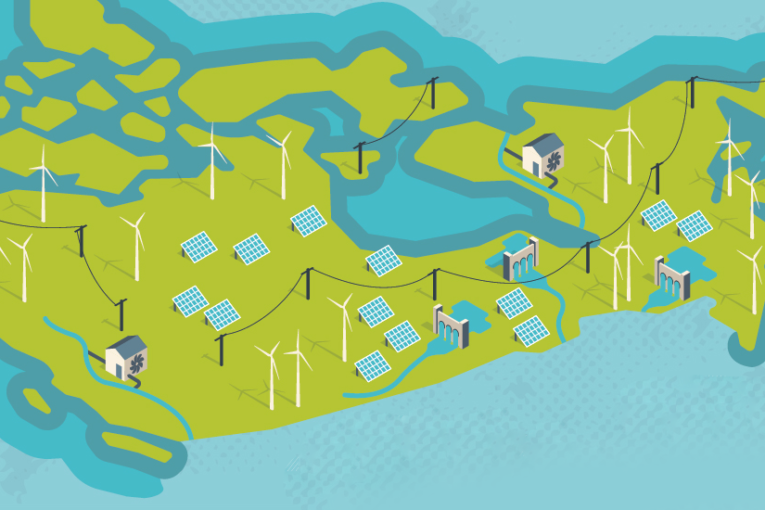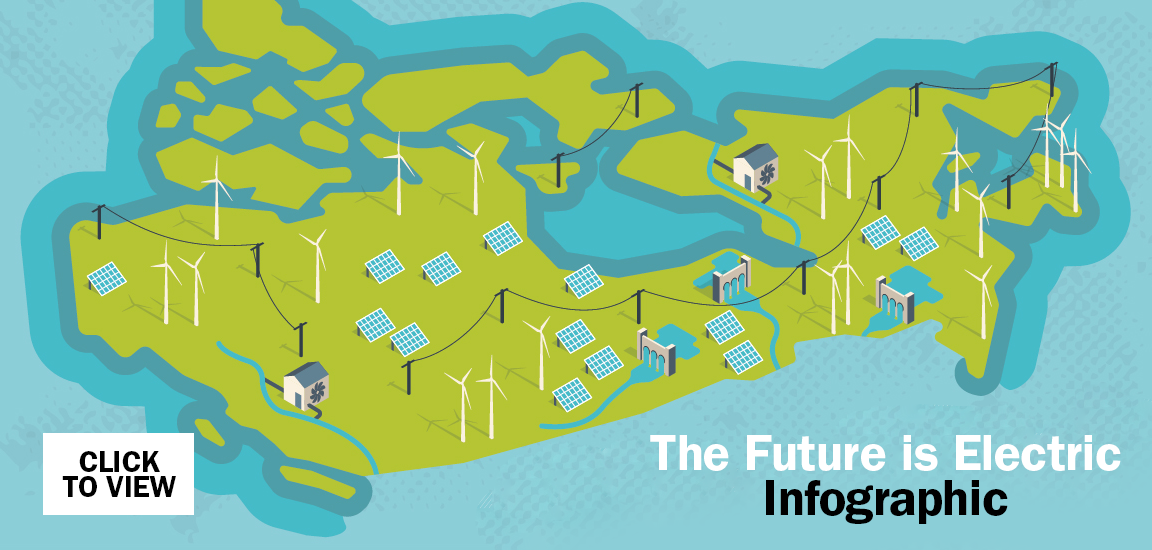
It’s early morning, 2067. You tap your phone to silence the buzzing alarm, which activates your home’s automated ‘wake up’ setting. A soft glow fills your room as a network of LEDs reaches just the right level of brightness. You roll out of bed, stepping onto floors warmed by a system that draws in heat from the outside air. As you shower in water heated by the solar panels on your roof, your coffee maker kicks into action, running on clean electricity stored in a battery in the garage. After breakfast, you’ll head to work in your electric SUV, realizing as you pass a deserted gas station that you can’t remember the last time you stopped to fill up.
In the decades ahead, our homes and workplaces will master the art of energy efficiency. Buildings will maximize comfort and use as little power as possible, automatically drawing the blinds as the days warm up, turning on fans to keep air circulating and switching on lights as darkness falls.
This scenario is already a reality for some Canadians. Fifty years from now it will be the norm.
Canada is on the cusp of a clean growth century. The ways we produce and use energy are in the midst of profound change, shaped by emerging technologies and market dynamics.
As we mark the 150th anniversary of Confederation, it can be tough to imagine how different life in Canada will be a hundred years from now.
But remember, thirty years ago cellphones had the heft of a cinder block and plugged into a car’s cigarette lighter for power. Today, we carry tiny computers in our pockets.
Unlike cellphone technology, energy infrastructure has a long lifespan. A lot of the infrastructure we’re building now—from power lines to new homes—will still be operating in the middle of this century. We need to start building infrastructure and prioritizing economic development that aligns with the future we envision, rather than for today’s limitations.

So, how do we get there?
We’re already on our way.
The final weeks of 2016 delivered some progress, as Prime Minister Justin Trudeau and other premiers negotiated a new national climate plan. The deal is a game-changer. It marks the moment that Canada stopped arguing about whether to tackle climate change and started figuring out how we’re going to get there.
We can each be part of the solution by reducing the amount of energy we use, making sure our homes and workplaces are well insulated and choosing energy efficient appliances. When the time comes to upgrade our cars, washing machines and refrigerators, we can take advantage of rebates that cut the cost of electric models. In our homes, we can install smart technology—like automated thermostats—to cut down on energy waste and reduce power bills.
Even industries that use a lot of energy, like mining and manufacturing, could become leaders in sustainability. It would mean investing in energy-saving technology, making their operations more efficient and running conveyor belts, robots and other equipment off locally produced renewable electricity.
“All this innovation merits a champion: our provincial and federal governments can help Canadian companies find new customers at home and abroad.”
Meanwhile, laboratories and factories in Ontario, Quebec and British Columbia are making breakthroughs in areas like energy storage, which makes it possible to access clean power even when the sun isn’t shining and the wind isn’t blowing. Canada’s cleantech engineers and automobile technicians will find new opportunities designing or manufacturing components that will be in-demand as our homes and vehicles get ever smarter and more efficient.
All this innovation merits a champion: our provincial and federal governments can help Canadian companies find new customers at home and abroad.
Pursuing clean growth will take support from all levels of government, with policies that put a cost on carbon pollution and reward change, build electricity transmission lines between provinces, expand electric vehicle and transit infrastructure and more.
Of course, even the best policies won’t produce lasting results unless Canadians fight for them and take ownership for our role in the energy transition. Global momentum toward clean energy may be “irreversible,” as former U.S. president Barack Obama recently wrote in the journal Science—but it’s up to us whether Canada catches that wave or misses out.
We can learn from the past
Fortunately, clean energy has always been part of Canada’s DNA.
In remote corners of the newly minted Dominion of Canada, rushing rivers turned the waterwheels that powered the lumber mills that built the places we inhabit today. The first electric lights were switched on in Winnipeg shortly after Confederation. By the turn of the 20th century, hydro power was lighting up towns and cities from coast to coast.
While Canada’s history is rooted in the past, it is also in the making. Our country is home to some of the world’s best clean energy resources, and fully two-thirds of our power is generated from renewable sources like hydro, wind and solar.
Recent government commitments to phase out coal and invest in clean energy infrastructure mean the share of renewable power in Canada’s energy mix is poised to grow. The global shift from fossil fuels to clean energy is opening up huge opportunities and Canada has the expertise to deliver solutions around the world.
Looking to our heritage, we can make clean growth the next chapter in Canada’s history—building a nation that’s electric, connected, and stronger than ever.
This article was originally published on CBC.
You can read more of the news on source





